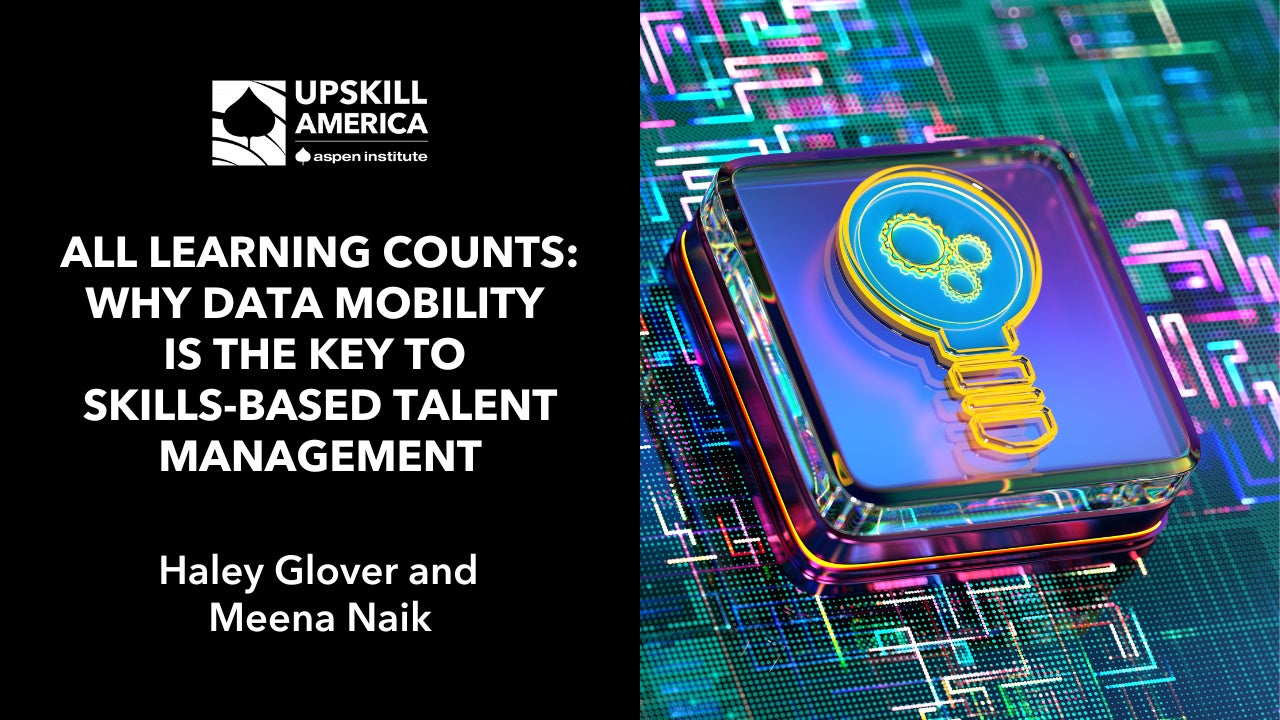All Learning Counts: Why Data Mobility Is the Key to Skills-Based Talent Management – The Aspen Institute


In the quest to reshape the workforce, one goal is becoming increasingly clear: all learning counts. This isn’t just a catchphrase — it’s a call to action for employers, educators, and job seekers alike. At the heart of this movement lies the concept of data mobility, or the ability to access, share, and interpret data freely across platforms and systems. Data mobility, however, isn’t just about technological ease; it’s about creating a more inclusive workforce that values individuals for what they know and can do, no matter where they learned it. By enabling skills data to move seamlessly across employers, education providers, and workforce agencies, we can build a skills-first economy that values all forms of learning and promotes the agility we need for the workforce needs of tomorrow. But creating a system where skills data flows smoothly and reliably isn’t easy.
Data mobility enables us to move beyond isolated records and siloed information, allowing skills-based talent management to become a more precise and effective process. True data mobility means that skills data isn’t confined to a single platform or organization, but can be securely shared and verified across sectors, empowering both individuals and employers. To achieve this, systems must be able to store and interpret skills data in a way that makes sense for everyone involved, from job seekers to employers. Enter learning and employment records (LERs). As a tool, these records, if created well with quality data that can move, allow job seekers to present the full spectrum of their learning and experience and enable employers to more easily verify the skills they seek. Without actualizing data mobility, we simply don’t have a functioning system; we have an assortment of unconnected parts with unreliable data that works for no one.
Often, however, the LERs and underlying technology can feel overwhelming and confusing. The reality is that while technology and standards play an important role, we don’t all need to be experts in the underlying tech. We care that the plumbing in our homes works reliably, but we don’t really want to get into the gritty details of how the pipes were installed. In the same way, the technology behind LERs needs to work seamlessly in the background, leaving the technical intricacies to the experts and focusing instead on making sure the skill validation process is clear, accessible, and intuitive for all stakeholders. Recruiters and hiring managers are increasingly pressed for time, on average spending just six seconds on each resume. We need to build systems that make those six seconds count, giving hiring managers a crystal-clear view of what candidates can do without them needing to dig into the technical underpinnings. When data moves freely, we don’t just enable hiring; we create an ecosystem where skills are visible, transferable, and valued across industries.
The rise of generative AI has transformed the job application process, allowing job seekers to create resumes and cover letters with a few clicks. While this convenience has benefits, it also contributes to an overwhelming volume of applications that often look identical, making it harder for recruiters to differentiate candidates. Without clear differentiation, skills-based assessments become essential for hiring managers looking to find the right fit amid a sea of sameness.
Data mobility can counterbalance this trend by emphasizing validated skills over polished but potentially superficial resumes. Candidates should be able to submit a genuine reflection of what they know and can do without getting lost in the monotony of generated language. Imagine a system that could identify validated skills instantly, stripping out any unnecessary frills to get to the core of a person’s competencies.
In a workforce that’s more mobile than ever, and a market that requires rapid changes in the skills required to do jobs, our systems must keep up. On the one hand, technology needed for work changes so rapidly that by the time everyone is trained on the use of new tools, the technology itself is obsolete. On the other hand, people no longer stay in one place or one industry for an entire career, and our systems need to capture and contextualize the skills people acquire across a lifetime of learning. This adaptability is critical as technology changes the nature of work and learning. In short, if skills data isn’t mobile, then neither are the people who hold those skills.
Skills data is more than just a record of experience; it’s a story about what a person can bring to the table. Data mobility allows this story to unfold across platforms, capturing learning from every stage of a person’s journey and presenting it in a form that employers can trust. Access to verified skills data is essential for employers facing high attrition, talent shortages, and the rise of AI-generated resumes. Employers need more than just static resumes and lists of past roles; they need insight into the true competencies of candidates and employees.
Not only will employers be able to see the full story of a person’s capabilities, but they will also be able to better retain, develop, and deploy talent where it’s most needed. This is especially relevant in a job market inundated with applications; data mobility ensures that the right skills surface, helping employers sift through the noise.
A common misconception about data mobility is that it requires perfect data or a complete overhaul of our existing systems. But data mobility isn’t an “all or nothing” proposition — it’s about taking incremental steps that bring us closer to a flexible, agile system.
One example of the “all or nothing” mindset is skill taxonomies. Many companies feel they need to reinvent the wheel by building new systems from scratch, but this isn’t the case. Rather than attempting to build a whole new taxonomy for skills, companies can instead focus on the roles that matter most, refining what’s most critical and needed for those roles and then partnering to identify talent and meet those needs. Success lies not in going it alone, but in joining forces with others to build a flexible, agile system that grows over time.
One of the biggest challenges to data mobility is that different sectors — employers, education providers, workforce agencies — often work in silos, each with their own data and definitions. But no one sector “owns” skills. True data mobility requires us to break down these barriers and work together, sharing information in a way that benefits everyone. By working together, we can create a future where skills flow freely between educational institutions, workplaces, and workforce systems, making it easier for individuals to find meaningful work and for employers to find skilled talent.
We share a vision for the future where data mobility has unlocked a truly agile system of work and learning, a system that reflects the changing profile of the workforce — where generations want a flexible approach to career development. In this future, job seekers can present a complete picture of their skills, employers can access validated competencies without endless filtering, and educational institutions are recognized for the incredibly important role they play in skill-building.
This vision is not just about data; it’s about designing a more meritocratic system that recognizes the value of all learning. With effective data mobility, we’re one step closer to realizing a workforce system where everyone’s skills are recognized, whether earned in a classroom, on the job, or even in life roles such as caregiving.
For this vision to become a reality, every stakeholder has an active role to take. Whether you’re an employer, an educator, or a tech developer, partner with each other to share data responsibly, advocate for interoperability, and demand better data practices from vendors. Most importantly, share your successes and challenges — because it’s the trailblazers who will lay the groundwork for everyone else.
Together, we have a unique opportunity to build a future where all learning counts. By embracing data mobility, we’re not just building better systems; we’re creating an opportunity to support an inclusive workforce where potential is more important than pedigree.
UpSkill America supports employers and workforce organizations to expand and improve high-quality educational and career advancement opportunities for America’s front-line workers. We seek to create a movement of employers, civic organizations, workforce intermediaries, and policymakers working collaboratively to implement education, training, and development strategies that result in better jobs and opportunities for front-line workers, more competitive businesses, and stronger communities. Follow us at www.upskillamerica.org and
linkedin.com/company/aspeneop
The Economic Opportunities Program advances strategies, policies, and ideas to help low- and moderate-income people thrive in a changing economy. Follow us on social media and join our mailing list to stay up-to-date on publications, blog posts, events, and other announcements.

Tax refunds in early 2026 could be $1,000 to $2,000 larger for many households due to retroactive tax law changes....

Why does it feel like large companies always get the upper hand? Maybe it’s the long contracts with fine print,...

What can you do if you can’t afford college? Maybe the financial aid award wasn’t enough, or you only want...